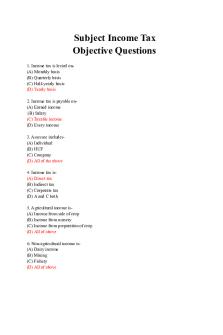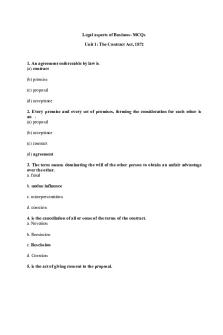Mid-term mcqs - mcqs of kinesiology 1st semester of DPT PDF

| Title | Mid-term mcqs - mcqs of kinesiology 1st semester of DPT |
|---|---|
| Course | kinesiology |
| Institution | Liaquat University of Medical & Health Sciences |
| Pages | 6 |
| File Size | 57.5 KB |
| File Type | |
| Total Downloads | 50 |
| Total Views | 152 |
Summary
mcqs of kinesiology 1st semester of DPT...
Description
1. The characteristics of any starting position ______. a. Stable b. Comfortable c. Provide room for full range of motion d.All of the above
2. In normal standing, line of gravity passes_______the knee joint. a. In front of b. Behind c. Through d. Lateral to
3. Muscle is most efficient in______ range. a. Outer b. Outer part of middle c. Inner part of middle d. Inner
4. Relaxed passive movement is useful for________. a. Muscle strengthening b. Improving joint range of motion c. Remembrance of pattern of movement d. Improving co-ordination
5. Stretching is the _____. a. Slow and sustained forced passive movement b. Sudden but controlled forced passive movement c. Relaxed passive movement d. Manipulation 6. The movements which are part of normal joint movement, but cannot be performed in isolation voluntarily are called a. Passive movements b. manipulations c. accessory movements d. mobilization
7. The muscle will be assigned a grade 3 (FAIR), when it completes its range against a. Strong resistance b. against gravity c. maximum resistance d. against no resistance
8. To test shoulder flexors in grade 2 (POOR), the patient position will be a. Side lying b. supine c. prone d. short sitting
9. __________ suspension tends to limit the movement of the part to a small-range movement each side of the central resting position. a. Pendular resistance b. incline suspension c. axial suspension a. all of the above 10. Demonstrating the difference between maximal contraction and the degree of relaxation which follows it, is called ___________. a. Progressive relaxation b. consciousness of breathing c. contrast method of relaxation d. relaxed passive movements
11. In walk-standing all of the movements are included except; a. Hip-flexion b. knee-extension c. ankle-dorsiflexion i. ankle plantar-flexion
12. By altering arm pick the correct one; a. Swing standing b. bent standing c. lunge standing d. heave standing
13. Relaxing the particular part or segment of the body is called _______________.
a. b. c. d.
Mental relaxation emotional relaxation Segment relaxation local relaxation
14. Passive movements include; a. Resisted movements b. manipulation c. accessory movements d. a&c
15. These types of free exercises are formed to increase the joint range in multi-joints or to increase the strength of many group or the total body muscles. a. Localized body b. assistive c. general body d. resistive body
16. Exercise regimens are; a. De lorme&walkins b. mac Queen c. zinovieff d. all of the above
17. CPM is used for _________. a. Weights b. pulleys a. flexion c. relax passive movements
18. Power = ______________. a. Distance/force x time b. time + force x distance c. forcex distance/time d. distance x force/time
19. High intensity exercise carried out over a short period of time called as ____________. a. Aerobic
b. ascorbic c. assistive a. anaerobic
20. By altering the leverage the resistance of an object felt by the muscle differs and depends on the position of ________. a. Lever b. fulcrum c. load arm d. tension
21. It is 75cm in length and 3-4 cm width, has D rings and used for wrist and ankle region. a. Head sling b. single sling c. double sling d. three-ring sling
22. Made-up of metal, contains forearm pad with the supporting strap adjustable handpiece and rubber ferrule. a. Elbow crutch b. gutter crutch c. axillary crutch d. simple crutch
23. This is the distance between heel strike of one lower extremity to the heel strike of the same lower extremity once again to the ground ___________. a. Step length b. step duration c. cadence d. stride length
24. The action of muscle group is determined by _________ in motor pathways. a. Efferent pathways b. afferent pathways c. neuronal pathways d. spinal pathways
25. Loss of function of cerebellum results in ___________.
a. b. c. d.
Cerebellar ataxia anosmia parkinsonism cerebellar spasm
26. Pulleys are used for __________ a. Make the work easy b. Alter the direction of motion c. Gain mechanical efficiency d. All of the above
27. The definition of Center of Gravity is: a. The point in the body that is the heaviest; usually at the level of the pelvis in anatomical position b. The point in the body that is the lightest; usually at the level of C-4 in anatomical position c. The point in the body where mass is equally distributed; usually at S-2 in anatomical position d. The point in the body where mass remains static; usually at S-2 in anatomical position
28. Tripping over a book on the floor and using your hands to catch your balance is an example of: a. Newton's Law #1 b. Newton's Law #2 c. Newton's Law #3 d. Newton's Law #4
29. Which of the following situations has the most stability? a. Wide base of support, high center of gravity, weight of body outside the base of support perimeter b. Narrow base of support, low center of gravity, weight of body within the base of support perimeter c. Narrow base of support, high center of gravity, weight of body above the base of support perimeter d. Wide base of support, low center of gravity, weight of body within the base of support perimeter
30. The patient should at least have muscle power 2 for suspension therapy exercises. (Muscle power 2: is _____________). a. Limb movement, but not against gravity b. Limb movement, but against gravity c. Flicker movement, not against gravity d. Full range of motion, but not against gravity 31. In sling rope the length of rope is ___________.
a. b. c. d.
2M 1.5 M 1M 2.5 M...
Similar Free PDFs

MCQs Paradigm Of - MCQ
- 13 Pages

Theory of Computation MCQs
- 9 Pages

MCQs of Performance Management
- 5 Pages

MCQs - MCQs
- 6 Pages

MCQs Of Air Pollution
- 3 Pages

MCQs of Project Management
- 13 Pages

MCQs
- 203 Pages

FAFL MCQs - MCQs
- 21 Pages

MCQs of Income Tax Pakistan
- 10 Pages

Immunology MCQs - MCQs
- 15 Pages
Popular Institutions
- Tinajero National High School - Annex
- Politeknik Caltex Riau
- Yokohama City University
- SGT University
- University of Al-Qadisiyah
- Divine Word College of Vigan
- Techniek College Rotterdam
- Universidade de Santiago
- Universiti Teknologi MARA Cawangan Johor Kampus Pasir Gudang
- Poltekkes Kemenkes Yogyakarta
- Baguio City National High School
- Colegio san marcos
- preparatoria uno
- Centro de Bachillerato Tecnológico Industrial y de Servicios No. 107
- Dalian Maritime University
- Quang Trung Secondary School
- Colegio Tecnológico en Informática
- Corporación Regional de Educación Superior
- Grupo CEDVA
- Dar Al Uloom University
- Centro de Estudios Preuniversitarios de la Universidad Nacional de Ingeniería
- 上智大学
- Aakash International School, Nuna Majara
- San Felipe Neri Catholic School
- Kang Chiao International School - New Taipei City
- Misamis Occidental National High School
- Institución Educativa Escuela Normal Juan Ladrilleros
- Kolehiyo ng Pantukan
- Batanes State College
- Instituto Continental
- Sekolah Menengah Kejuruan Kesehatan Kaltara (Tarakan)
- Colegio de La Inmaculada Concepcion - Cebu





